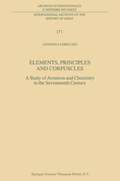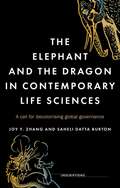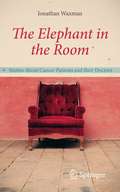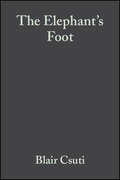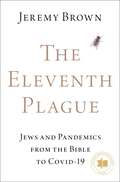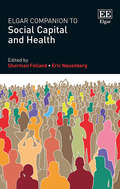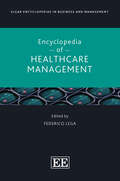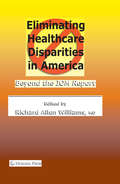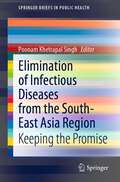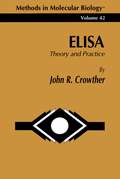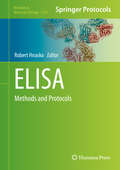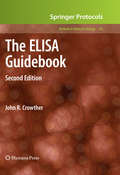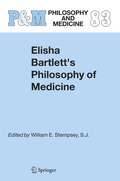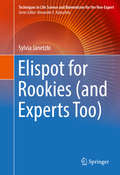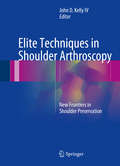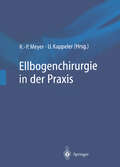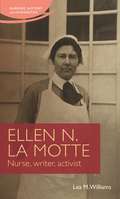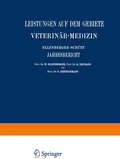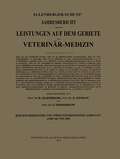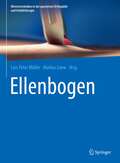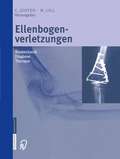- Table View
- List View
Elements, Principles and Corpuscles: A Study of Atomism and Chemistry in the Seventeenth Century (International Archives of the History of Ideas Archives internationales d'histoire des idées #171)
by Antonio ClericuzioIn Elements, Principles and Particles, Antonio Clericuzio explores the relationships between chemistry and corpuscular philosophy in the age of the Scientific Revolution. Science historians have regarded chemistry and corpuscular philosophy as two distinct traditions. Clericuzio's view is that since the beginning of the 17th century atomism and chemistry were strictly connected. This is attested by Daniel Sennert and by many hitherto little-known French and English natural philosophers. They often combined a corpuscular theory of matter with Paracelsian chemical (and medical) doctrines. Boyle plays a central part in the present book: Clericuzio redefines Boyle's chemical views, by showing that Boyle did not subordinate chemistry to the principles of mechanical philosophy. When Boyle explained chemical phenomena, he had recourse to corpuscles endowed with chemical, not mechanical, properties. The combination of chemistry and corpuscular philosophy was adopted by a number of chemists active in the last decades of the 17th century, both in England and on the Continent. Using a large number of primary sources, the author challenges the standard view of the corpuscular theory of matter as identical with the mechanical philosophy. He points out that different versions of the corpuscular philosophy flourished in the 17th century. Most of them were not based on the mechanical theory, i.e. on the view that matter is inert and has only mechanical properties. Throughout the 17th century, active principles, as well as chemical properties, are attributed to corpuscles. Given its broad coverage, the book is a significant contribution to both history of science and history of philosophy.
The elephant and the dragon in contemporary life sciences: A call for decolonising global governance (Inscriptions)
by Joy Y. Zhang Saheli Datta BurtonThis book provides a powerful diagnosis of why the global governance of science struggles in the face of emerging powers. Through unpacking critical events in China and India over the past twenty years, it demonstrates that the ‘subversiveness’ assumed in the two countries’ rise in the life sciences reflects many of the regulatory challenges that are shared worldwide. It points to a decolonial imperative for science governance to be responsive and effective in a cosmopolitan world. By highlighting epistemic injustice within contemporary science, the book extends theories of decolonisation.
The elephant and the dragon in contemporary life sciences: A call for decolonising global governance (Inscriptions)
by Joy Y. Zhang Saheli Datta BurtonThis book provides a powerful diagnosis of why the global governance of science struggles in the face of emerging powers. Through unpacking critical events in China and India over the past twenty years, it demonstrates that the ‘subversiveness’ assumed in the two countries’ rise in the life sciences reflects many of the regulatory challenges that are shared worldwide. It points to a decolonial imperative for science governance to be responsive and effective in a cosmopolitan world. By highlighting epistemic injustice within contemporary science, the book extends theories of decolonisation.
The Elephant in the Room: Stories About Cancer Patients and their Doctors
by Jonathan WaxmanThe Elephant in the Room is a collection of short stories that creatively communicate the cancer patient’s journey. The stories, based on real-life accounts, are built around the idiosyncratic relationships between patients and their doctors. Using humor, empathy and wisdom, Jonathan Waxman explores the very human side of cancer as well as providing expert commentary on the clinical aspects of diagnosis and therapy of this disease. These stories comfort and entertain, inform and engage, and are a treat to read for anyone whose life has been affected by cancer.
The Elephant's Foot: Prevention and Care of Foot Conditions in Captive Asian and African Elephants
by Blair Csuti Eva L. Sargent Ursula S. BechertMaintaining the healthy foot condition of captive Asian and African elephants is one of the most important yet most difficult tasks for zookeepers, veterinarians, and researchers. Recognizing the need for a convenient and comprehensive health care manual, Blair Csuti, Eva Sargent and Ursula Bechert present The Elephant's Foot. Born out of a national conference on elephant care and physiology, this book is backed by 46 of the foremost authorities on the subject. After a general overview of the elephant foot's anatomy and physiology, The Elephant's Foot leads practitioners through recognition, prevention, and treatment of a variety of foot problems. From nail infections to foot abcesses, readers will find this text contains solutions for most foot troubles with remedies or additional recommendations. This book will support anyone simply studying elephants or those working with elephants on a daily basis.
The Eleventh Plague: Jews, Plagues, and Pandemics from the Bible to COVID-19
by Jeremy BrownA physician and historian of science and medicine at the National Institute of Health tells the hidden story of how plagues and pandemics shaped the history of the Jewish people. Plagues, pandemics, and infectious diseases have shaped the history of the Jewish people. Of course, there were the ten biblical plagues that famously smote the Egyptians--from the rain of frogs to the deaths of the firstborn--but that is just the start of the story. For the Talmudic Sages infectious diseases were part of the fundamental fabric of God's created world. In later times, however, disease was often thought to be caused by malign spells and incantations. A counter-magic developed to combat them. Amulets were deployed and miracle workers sought out. Surprisingly, Jeremy Brown shows, Jews sometimes even visited Christian shrines and beseeched the intervention of their saints. In 1348, when the Black Death swept through Europe, Jews fell victim both to the disease, for which they were blamed, and to the anti-Semitic violence that followed. At least 235 Jewish communities were persecuted even as Pope Clement IV ruled that anyone joining or authorizing the persecution would be excommunicated. In The Eleventh Plague, Brown investigates the relation between Judaism and infectious diseases throughout the ages, from premodern and early-modern plagues, to rabbinic responses to smallpox and cholera, to the special vulnerabilities Jewish immigrants faced in the US as result of prejudice, and to the curious practice of "Black Weddings" in which two orphans are married in a cemetery. Popularized during the 1918 influenza pandemic the practice was revived in response to the Covid-19 pandemic, showing that the intriguing relationship between Judaism and infectious disease remains relevant today.
The Eleventh Plague: Jews, Plagues, and Pandemics from the Bible to COVID-19
by Jeremy BrownA physician and historian of science and medicine at the National Institute of Health tells the hidden story of how plagues and pandemics shaped the history of the Jewish people. Plagues, pandemics, and infectious diseases have shaped the history of the Jewish people. Of course, there were the ten biblical plagues that famously smote the Egyptians--from the rain of frogs to the deaths of the firstborn--but that is just the start of the story. For the Talmudic Sages infectious diseases were part of the fundamental fabric of God's created world. In later times, however, disease was often thought to be caused by malign spells and incantations. A counter-magic developed to combat them. Amulets were deployed and miracle workers sought out. Surprisingly, Jeremy Brown shows, Jews sometimes even visited Christian shrines and beseeched the intervention of their saints. In 1348, when the Black Death swept through Europe, Jews fell victim both to the disease, for which they were blamed, and to the anti-Semitic violence that followed. At least 235 Jewish communities were persecuted even as Pope Clement IV ruled that anyone joining or authorizing the persecution would be excommunicated. In The Eleventh Plague, Brown investigates the relation between Judaism and infectious diseases throughout the ages, from premodern and early-modern plagues, to rabbinic responses to smallpox and cholera, to the special vulnerabilities Jewish immigrants faced in the US as result of prejudice, and to the curious practice of "Black Weddings" in which two orphans are married in a cemetery. Popularized during the 1918 influenza pandemic the practice was revived in response to the Covid-19 pandemic, showing that the intriguing relationship between Judaism and infectious disease remains relevant today.
Elgar Companion to Social Capital and Health
by Sherman Folland Eric NauenbergSherman Folland and Eric Nauenberg present the cutting edge of research covering the ever-expanding social capital field. With excellent contributions from leading academics, the Elgar Companion to Social Capital and Health offers a developed examination of new research across sociology, epidemiology, economics, psychology, and political science. Authors from across North America, Europe, and Asia provide wide-ranging and detailed accounts of social capital and health, focusing on social networks, causality, and productivity. Sections cover theoretical perspectives and empirical evidence supporting the connection between social capital and health worldwide. Authors discuss ageing, immigration, religion, and workplace health as well as focusing on social capital in developing countries experiencing rapid and extensive economic growth. Essential reading for any aspirational social capital and health policy academic, this Companion offers future paths for research within sociology, health economics, epidemiology, political science, and social policy. The breadth of study would also benefit public health officials, policy analysts, and healthcare decision-makers.
Elgar Encyclopedia of Healthcare Management (Elgar Encyclopedias in Business and Management series)
Management practices within the health care sector are shaped by a multitude of professional, social, political and technical factors. This Elgar Encyclopedia of Healthcare Management provides insights and definitions on essential themes that clarify complexity and specificity of leading within the health sector, as well as the latest trends in health policy that affects management practices. Its structure is built on the current agenda of health managers and health management scholars and it offers a broad look into new challenges and principles that are re-shaping managerial dynamics of the health sector and the way the health services should be designed and delivered.Key Features:117 accessible entries organized by themeAn up-to-date examination of emerging healthcare paradigmsOver 50 leading contributors from a variety of backgrounds and specialismsA balanced subject range aimed at improving the proficiencies of healthcare leaders, across technical skills and management practicesThis authoritative work will be incredibly useful for students and scholars of healthcare management, policy and economics.
Eliminating Healthcare Disparities in America: Beyond the IOM Report
by Richard Allen WilliamsIn this book, Dr. Richard Allen Williams has assembled the very best scholars on healthcare disparities to raise the public consciousness of this issue. Arranged into discrete categories, this volume contains comprehensive coverage, both historical and current, of the healthcare disparity crisis currently plaguing our country in hopes of leading us all to a brighter future.
Elimination of Infectious Diseases from the South-East Asia Region: Keeping the Promise (SpringerBriefs in Public Health)
by Poonam Khetrapal SinghThis book discusses the historical context, country experience, and best practices that led to eliminating infectious diseases from the WHO’s South-East Asia Region, such as malaria, lymphatic filariasis, yaws, trachoma, and mother-to-child HIV in the mid-twentieth and twenty-first century. The UN Sustainable Development Goals (3.3) targets to end AIDS, tuberculosis, malaria, and neglected tropical diseases and combat hepatitis, water-borne diseases and other communicable diseases by 2030. In this context, this book is of high significance to countries from the SEA region and around the globe. It helps create national strategies and action plans on infectious disease elimination and thus attaining SDG 3.3.
ELISA: Methods and Protocols (Methods in Molecular Biology #1318)
by Robert HnaskoThis volume is a practical biochemical guide to the Enzyme-Linked Immunosorbent Assay (ELISA), used to detect a target substance in a liquid sample. The ELISA is an important and widely used diagnostic tool in medicine, animal health, botany and quality assurance processes in food and beverage production. An introductory chapter orients the reader on the basic structure and function of immunoglobulins and their fragments while subsequent chapters outline the methodology to generate monoclonal antibodies using hybridoma technology and the general methods used to purify antibodies. Multiple chapters demonstrate how to creatively use the properties of the antibody to identify, localize and quantify target analytes to answer questions and resolve problems. The reader will learn how to use a variety of immunoassay strategies, reporters and detection systems that will undoubtedly facilitate their efforts to gain answers to their own questions. Written in the successful Methods in Molecular Biology series format, chapters include introductions to their respective topics, lists of the necessary materials and reagents, step-by-step, readily reproducible protocols and notes on troubleshooting and avoiding known pitfalls.Authoritative and easily accessible, ELISA: Methods and Protocols seeks to provide both professionals and novices with the technical information necessary for the reader to successfully use the immunoassay as part of the discovery process.
The ELISA Guidebook: Second Edition (Methods in Molecular Biology #516)
by John R. CrowtherThere have been very few developments that markedly affect the need to greatly revise the text from the last version of this book. This is testament to the fact that hetero- neous enzyme-linked immunosorbent assays (ELISA) provide ideal systems for dealing with a wide range of studies in many biological areas. The main reason for this success is test flexibility, whereby reactants can be used in different combinations, either attached passively to a solid phase support or in the liquid phase. The exploitation of the ELISA has been increased through continued development of specifically produced reagents, for example, monoclonal and polyclonal antibodies and peptide antigens coupled with the improvement and expansion of commercial products such as enzyme-linked conjugates, substrates and chromogens, plastics technology and design of microwell plates, inst- mentation advances and robotics. However, the principles of the ELISA remain the same. There has been some rearrangement of chapters plus addition of three new ones dealing with charting methods for assessing the indirect ELISA, ruggedness and robustness of tests-aspects of kit use and validation, and internal quality control and external quality management of data, respectively. These reflect the need to control what you are doing with ELISA and to exploit the method to its full extent. I do not apologize for dealing with the same areas in different ways a number of times, as it is imperative that principles are understood to allow planning, operation, and control of ELISA.
Elisha Bartlett's Philosophy of Medicine (Philosophy and Medicine #83)
by W. E. StempseyThe idea of preparing a new critical edition of Elisha Bartlett’s Essay on the Philosophy of Medical Science was suggested to me several years ago by Dr. H. Tristram Engelhardt, Jr. Since that time it has been a pleasure to get to know the life and work of Elisha Bartlett. I am pleased to be completing this book in the bicentennial year of Bartlett’s birth. Bartlett was born in 1804 in Smithfield, Rhode Island, less than twenty-five miles from Worcester, Massachusetts, my present home—a short journey even in Bartlett’s day. I have been able to walk at some of the sites to which Bartlett continually returned during his life. Visiting Bartlett’s grave in the Slatersville cemetery has been an inspiration for the preparation of this book. Proximity to several institutions with rich holdings in Bartlett’s works and in nineteenth-century American history of medicine greatly facilitated my research. First, though, I want to acknowledge the College of the Holy Cross for supporting my sabbatical leave for the academic year 2003-2004. The American Antiquarian Society, in Worcester, Massachusetts, was generous in giving me access to its remarkable resources. I was able to find many of Bartlett’s published works and other nineteenth-century medical literature there, and the entire library staff provided quick and able research assistance.
Elispot for Rookies (Techniques in Life Science and Biomedicine for the Non-Expert)
by Sylvia JanetzkiThis book provides basic, simple, and logical explanations for choices to be made to run the best Elispot possible. It allows the newcomer to truly understand the best options for specific protocol steps, reagents and materials, and provides even the experienced Elispot user with insight into best practices. The techniques presented here are supported by the author’s twenty-plus years of first-hand experience working with this assay, as well as the shared experiences of numerous colleagues and collaborators.The enzyme-linked immunospot (Elispot) assay is a widely used technique to monitor cells on the single cell level for the release of analytes like cytokines, chemokines or immunoglobulins (antibodies), in response to particular stimuli. The most important feature of Elispot is its outstanding sensitivity, allowing the detection of specific cells in very low frequencies. The advantages of Elispot have resulted in it being widely adapted for use in research and translational applications in numerous fields including cancer, infectious diseases, autoimmunity, and transplantation.
Elite Techniques in Shoulder Arthroscopy: New Frontiers in Shoulder Preservation
by John D. KellyIdeal for shoulder surgeons who want to upgrade their skills to the next level, this practical, step-by-step text presents the latest cutting-edge management strategies and science aimed at shoulder preservation surgery. Highlighting four main areas - the overhead athlete, shoulder instability, glenohumeral arthritis, and the rotator cuff - these innovative techniques focus on the maintenance of the native shoulder joint. Chapters open with an introduction to the clinical problem, followed by misgivings related to open surgery or arthroplasty as treatment strategies. A rationale for the arthroscopic treatment is then presented, along with an in-depth description of the technique itself as well as preliminary results. Techniques presented include posterior capsule release for the overhead athlete, arthroscopic Latarjet for instability, the CAM procedure for glenohumeral arthritis, biological augmentation for rotator cuff repair. A fifth section covers post-operative care and return-to-play considerations. With contributions from many of the top thinkers and surgeons of the shoulder, Elite Techniques in Shoulder Arthroscopy brings these exciting new management strategies to the fore with the aim of elevating them to more common practice for orthopedic surgeons and sports medicine specialists.
Elites, Policies and State Reconfiguration: Transforming the French Welfare Regime (International Series on Public Policy)
by William Genieys Mohammad-Saïd DarvicheThis book examines the history of the French welfare state from the mid-twentieth century to the present day. The French social security system has changed profoundly over the last few decades. The Bismarkian model of governance and social protection inherited from the Second World War has progressively faded away in favor of a reinforcement of the state’s capacity to intervene on policies and the implementation of national health insurance coverage. In order to understand this major transformation, this book draws on rich original sources to offer a historical and sociological perspective on elite policymakers and policy change. In doing so, it identifies correlations between the changing social backgrounds and career paths of elites in charge of social insurance policies since the 1940s, and the development of health policy programs. It will appeal to all those interested in public policy, health policy, social studies and French history and politics.
Ellbogenchirurgie in der Praxis
by Rainer-Peter Meyer Urs Kappeler"Ellbogenchirurgie" bietet Ihnen einen einzigartig praxisorientierten Überblick über dieses Spezialgebiet.Aktuelles Fachwissen mit Praxis-Pluso Anerkannte Organspezialisten stellen konzentriert direkt umsetzbare Therapiekonzepte vor, ergänzt durch die Langzeitresultate der konservativen und operativen Verfahren.o Die klar strukturierten Kapitel sind einheitlich gegliedert nach Indikationen, Techniken und Komplikationen und umfassen die modernsten Untersuchungsmethoden.o Umfangreiches Abbildungsmaterial, zahlreiche Fallbeispiele und eigene Praxiserfahrungen der Autoren machen das Buch ungewöhnlich lebendig und anschaulich.Ihre Sicherheit in Weiterbildung und täglicher Praxis-> Fundiertes Diagnostik-Wissen-> Entscheidungshilfen für die rechtzeitige Indikation-> Das Handwerkszeug für die erfolgreiche Therapie
Ellen N. La Motte: Nurse, writer, activist (Nursing History and Humanities)
by Lea WilliamsUsing unexamined sources, including diaries and unpublished manuscripts, this biography traces the life and work of nurse, writer, and activist Ellen N. La Motte (1873-1961), examining how she developed as a professional in the early twentieth century.
Ellen N. La Motte: Nurse, writer, activist (Nursing History and Humanities)
by Lea WilliamsEllen La Motte: nurse, writer, activist, is a biography of La Motte that traces the arc of her life, from her birth in Louisville, Kentucky, in 1873 to her death in Washington, D.C. in 1961. It integrates original unexamined sources such as diaries, unpublished manuscripts, and publishing contracts along with primary sources—letters, newspaper articles, health department reports, and public records—with an examination of her prolific published writings, about topics as diverse as tuberculosis nursing, women’s suffrage, nursing during the Great War, and the opium trade. It considers of how she developed as a nurse, writer, and activist once she entered the Johns Hopkins Training School for Nurses in 1898 and grew into a potent force in the anti-tuberculosis campaign. Gaining experience speaking and writing on behalf of controversial causes, La Motte put her talents to use on behalf of the fight for the vote for women, nursing during World War I and the anti-opium campaign.
Ellenberger-Schütz’ Jahresbericht über die Leistungen auf dem Gebiete der Veterinär-Medizin: Fünfundvierzigster Jahrgang(Jahr 1925)
by St. Angeloff M. Schristiansen NA Constantinecu H. Dexler A. Fischer L. Freund Frick St. Gajewski Götze W. Grimmer K. Heuss NA Hnsersson F. v. Hutyra C.O. Jensen E. JoestDieser Buchtitel ist Teil des Digitalisierungsprojekts Springer Book Archives mit Publikationen, die seit den Anfängen des Verlags von 1842 erschienen sind. Der Verlag stellt mit diesem Archiv Quellen für die historische wie auch die disziplingeschichtliche Forschung zur Verfügung, die jeweils im historischen Kontext betrachtet werden müssen. Dieser Titel erschien in der Zeit vor 1945 und wird daher in seiner zeittypischen politisch-ideologischen Ausrichtung vom Verlag nicht beworben.
Ellenberger-Schütz’ Jahresbericht über die Leistungen auf dem Gebiete der Veterinär-Medizin
by Prof. Dr. Ellenberger Prof. Dr. Neumann Prof. Dr. ZietzschmannDieser Buchtitel ist Teil des Digitalisierungsprojekts Springer Book Archives mit Publikationen, die seit den Anfängen des Verlags von 1842 erschienen sind. Der Verlag stellt mit diesem Archiv Quellen für die historische wie auch die disziplingeschichtliche Forschung zur Verfügung, die jeweils im historischen Kontext betrachtet werden müssen. Dieser Titel erschien in der Zeit vor 1945 und wird daher in seiner zeittypischen politisch-ideologischen Ausrichtung vom Verlag nicht beworben.
Ellenbogen (Meistertechniken in der operativen Orthopädie und Unfallchirurgie)
by Lars Peter Müller Markus LoewDie Buchreihe „Meistertechniken in der operativen Orthopädie und Unfallchirurgie“ erlaubt es dem operativ tätigen Orthopäden und Unfallchirurgen, den Autoren - alle sind Meister ihres Faches - beim Operieren direkt über die Schulter zu schauen. Beschrieben werden häufige, aber erfahrungsgemäß schwierige Probleme und Techniken so, dass der erfahrene, aber im jeweiligen Gebiet nicht hochspezialisierte Operateur den behandelten Eingriff mit höherer Sicherheit auszuführen vermag. Alle Beschreibungen lassen sich direkt in die Praxis umsetzen: die Operationsverfahren werden step-by-step dargestellt und mit zahlreichen Fotos und brillanten Grafiken visualisiert.Initiiert und begleitet wird die Reihe durch Prof. Dr. med. D. Kohn und Prof. Dr. med. T. Pohlemann. Herausgeber des vorliegenden 5. Bandes Ellenbogen sind Prof. Dr. med. L. Müller und Prof Dr. med. M. Loew.
